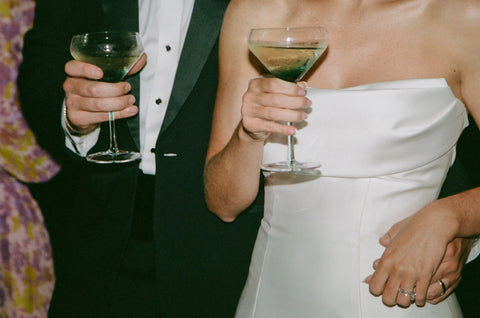Tuxedo shirt styles are like forearm tattoos: painstakingly detailed, and usually covered by a jacket. Thankfully, tuxedo shirts do not require laser removal if they turn out poorly, but you’ll save time and money by getting your tux shirt style—and your ink—right the first time. We'll help with the shirt.
While there are many types of tuxedo shirts, it all comes down to how formal or casual, (or traditional, or modern) you want your look to be.
Shop All Tuxedo Shirt Styles →
Quick Reference
Choosing a tux shirt is largely about personal preference. While knowing the finer points can help you better align what you want with what you’re wearing, we're here for the busy people, too.
Use this quick reference section to find the right style, or read on to become a certified expert.

Glossary
Definitions for common tuxedo shirt terms
-
Pleat: A fold in fabric held by stitching
-
Bib: Double-layered rectangular panel on the shirt front
-
Placket: Center strip that houses the buttonholes
-
Studs: Removable decorative fasteners used instead of buttons
Neckwear Rules
How to wear ties with tuxedo shirts
-
Rule 1: If your shirt has a bib, always wear a bow tie.
-
Rule 2: If your shirt has a wing tip collar, always wear a bow tie.
-
Rule 3: If your shirt has a spread collar, wear a bow tie or a necktie—unless it has a bib (see Rule 1).
Frequently Asked Questions
Solutions to common tux shirt problems
-
Q: Does my shirt need to have french cuffs for cufflinks?
A: Usually, and french cuffs require cufflinks or silk knots. (Our shirts work with cufflinks regardless of cuff style.) -
Q: Should I wear button studs?
A: If you’re wearing a bow tie, yes—but they’re not required. (Tip: Make sure they work with your tux shirt placket.) -
Q: Does my shirt need a pleated bib shirt or wing tip collar?
A: No, but pleated bibs and wing tips make for a polished, classic look. -
Q: How should a tuxedo shirt fit?
A: Two fingers should fit between your neck and the shirt collar, sleeves should end at your wrist, and there should be minimal fabric bunching in the waist when tucked in.
Table of Contents
- Parts of a Tuxedo Shirt
- Tuxedo Shirt Fabrics
- Accessories
- Colors
- Fit
- Care
Tuxedo Shirt Collar Styles
The collar of your tuxedo shirt should not be overlooked, because your shirt collar frames your face. And people tend to glance toward faces when they’re not looking at their phones.
Spread Collar White Dress Shirt by The Black Tux
Spread Collar Tuxedo Shirt
This is the most common type of collar today and the most versatile. Spread collar shirts play well with suits and tuxedos alike, and both bow and neckties. Spread collars also come in a variety of points and angles—from the forward point collar with its narrow spread, to the cutaway collar’s wide spread (the “spread” refers to the distance between the collar points). Our spread collar tuxedo shirts are designed with a semi-spread collar, or “Raymond of collar spreads” which as you'd imagine, everyone loves.
Wing Tip Fly-Front Tuxedo Shirt by The Black Tux
Wing Tip Collar
The wing tip gets its name from the fold-out collar points that look like wings. It’s the most formal shirt collar option, designed to be worn with a bow tie and tuxedo. We don't recommend wearing a wing tip shirt with a suit or necktie.
Less Common Tuxedo Shirt Collars
A band collar shirt, or Nehru collar shirt, is designed to be worn without a tie, making it instantly casual. Band collars are on the edges of the tuxedo shirt style spectrum, and to be honest, your neckline will look pretty empty without a tie.
Club collars and button downs are casual—too casual to wear with a tux. Save these collar styles for your suit.
Go back to Table of Contents
Tuxedo Shirt Bibs
Some dress shirts have a rectangular panel that runs up the front of the shirt. It’s called a “bib,” and it doubles your shirt’s chest fabric, ensuring that anything visible under your tuxedo jacket is bright white, not see-through. Only wear bib-front shirts with a tuxedo and bow tie.

Pleated Wing Tip Tuxedo Shirt by The Black Tux
Pleated Tuxedo Shirt Bib
Pleated bibs feature vertical pleats that run up both sides of the button placket, and are a traditional detail on tuxedo shirts. A modern, narrow pleat can add a little sophistication to an otherwise traditional look.

No Bib White Dress Shirt by The Black Tux
No Bib Tuxedo Shirt
The casual choice, tuxedo shirts without bibs are sleek, modern, and simple. If a bibbed tux shirt style feels a little too proper, nobody will miss it under your tuxedo jacket. Besides, there are many alternatives for adding texture to your look.
Piqué Tuxedo Shirt Bib
Piqué bibs, which are made from stiff fabric usually woven with a dimpled pattern, are considered slightly more formal than pleated bibs. The piqué weave was actually invented for white tie events, but you’ve probably worn a polo shirt or two that had a piqué collar.
Pockets on a Tuxedo Shirt
Bad news: If your tuxedo shirt has a breast pocket, it’s not a tuxedo shirt, and people will know something is off if you wear one.
Go back to Table of Contents
Tuxedo Shirt Plackets
The placket is the center strip of fabric where a shirt’s buttonholes are situated. And unsurprisingly given the density of this content thus far, you have several options to choose from when it comes to your tuxedo shirt placket.

Tuxedo Placket (Plain Front)
This style looks a lot like the French front (below), but the top four buttons are removable for tuxedo studs. Please, let this style live up to its name, and only wear it with tuxes—it should never make an appearance under your suit jacket.

Front Placket
The most common type of placket style, and one you usually can’t go wrong with. Fabric is folded over and sewn with a fused interlining for a classic (and symmetrical) look.

No Placket (French Front)
French front shirts don’t have that folded-over and sewn strip of fabric along the buttons. Going placket-less gives your shirt a cleaner, more minimalist feel, making it an ideal choice for both formal or casual shirts.

Covered Placket (Fly Front)
The fly front is a formal, modern style of placket in which an extra piece of fabric covers up the buttons on your shirt. Because sometimes you’ve got to leave a little to the imagination.
Go back to Table of Contents
Tuxedo Shirt Cuffs
If you tuxedo jacket fits properly, your shirt cuff will peak out from underneath. Show the world that your perfect fit wasn’t an accident, and put some thought into your shirt cuff style.

French Cuffs
French cuffs are formal shirt cuffs that are rolled back and held in place by cufflinks. If you’re getting married or going to another event that requires a tuxedo, formal French cuffs will elevate your look. Besides, you should always take an opportunity to add a set of cufflinks to your look.
Barrel Cuffs
Barrel cuffs don’t require any rolling or cufflinks—instead, they are held closed by buttons. Most of your shirts probably have barrel cuffs. Unlike the typical, casual barrel cuff shirt that buttons shut, our barrel cuff dress shirts have modified buttonholes that can also accommodate cufflinks, bringing them up to tux code.
Go back to Table of Contents
Tuxedo Shirt Fabrics
We live in a material world, so choose the right tuxedo shirt material. Sure, it’s a small detail, but in this case you may very literally end up sweating the small stuff. Nobody enjoys a soggy slow dance.
Cotton
Cotton is breathable, making it perfect for dress shirts and tuxedo shirts. There’s nothing more comfortable, or more classic, than a crisp cotton shirt to contrast texture against a wool tuxedo jacket.

White Linen Dress Shirt by The Black Tux
Linen
Linen has moisture wicking properties that create a cooling effect, so this is a great choice for humid, tropical, or just plain hot climates. Linen shirts aren't as good at insulating, so not the best choice if temps drop.
Other Fabrics
Some manufacturers use polyester to cut costs, adding durability and wrinkle resistance, but poly reduces breathability. What does that mean for you? Shirts that get very, very sweaty. You might spend three minutes ironing a cotton shirt, but at least it’s not a biohazard.
As for high-end alternatives to cotton, there’s silk. It’s hard to find a problem with the wearability of a silk tuxedo shirt—it’s hypoallergenic, regulates your body temperature well, and its soft hand-feel makes a kitten’s coat feel like burlap. The downside? Affordability—a quality silk tuxedo shirt can cost thousands of dollars.
Go back to Table of Contents
Accessories
The tuxedo shirt is actually where most of your tux accessories will live, and from cuff to collar, there are a lot of ways to personalize your look.

Octagon Milgrain Cufflinks & Studs Set by The Black Tux
Button Studs
Button studs lend your tuxedo shirt a more formal feel. They’re only for tux shirt styles, and are designed to fill the buttonholes of the shirt placket. Button studs are usually made of precious materials like gold, silver, or brass, and some have inlays like onyx or mother of pearl. If you’re also wearing a metallic cufflink, it’s best to match metals with your button studs.
Cufflinks
Wearing cufflinks is a simple way to add texture and shine when you’re wearing a formal outfit. We recommend a classic metallic style. Or keep your cuffs minimal with classic silk knots, like the ones in this shirt.
Shop Cufflinks & Button Studs ➝
Collar Stays
Collar stays hide in a small pocket on the underside of your shirt collar, keeping the edges looking crisp and pointy. They also weigh the collar down, making it less likely the edge of your tux jacket will cozy up awkwardly under your shirt collar.
Some collar stays (like ours) are made of precious materials—stainless steel, brass, mother-of-pearl, and gold, but a heavy plastic stay usually works just as well. Just avoid shirts with sewn-in collar stays—they should always be removed before ironing or starching.
Shop Collar Stays ➝
Neckwear
Bow ties are a tuxedo staple—the traditional neckwear for your tuxedo shirt.
- If the dress code is formal or black tie, alway wear a bow tie
- If the dress code leans casual (black tie optional, creative black tie, etc.) neckties can be worn
- Avoid wear a necktie with a wing tip collar (it looks very 90s prom and not in a good way)
- Do not neckties with pleated or bibbed tux shirts, or when wearing button studs
Pro Tip: Optimize your neckwear fabric to get the most mileage out of your tie choice.
Waist Coverings: Cummerbunds & Vests
One guiding principle of a formal dress code is that all the working parts of your outfit—including the intersection of your shirt and pant waist—must be covered. Strictly speaking, these are optional for a complete outfit, but worth considering.
Cummerbund
The cummerbund was invented to cover the awkward shirt bunching that tends to happen around your waistband. Cummerbunds are experiencing a bit of resurgence, so if you're interested, choose one that matches the color of your tuxedo pants or the satin accents on your pants (typically black).
Shop Cummerbunds ➝

Black Low-Cut Vest by The Black Tux
Low-Cut Vest
Like a cummerbund, you’d only need to wear a low-cut vest (or "waistcoat") at black tie events. Low-cut vests are viewed as more formal and are cut lower in the front than a typical suit vest to show off your tuxedo shirt’s bib and button studs if you're wearing them.
Shop Tuxedo Vests ➝
Go back to Table of Contents
Tuxedo Shirt Colors
Does a tuxedo shirt have to be white? That depends on where you’re wearing it.
White
Formal events, like black tie weddings, require a traditional white or ivory tuxedo shirt. Aside from these situations, there’s no hard rule that says you must wear a white shirt with your tuxedo, but it always looks great.
Other Colors
Pairing a black shirt with a tux is a casual move and the one we've seen the most, so double check the dress code before you opt for a black or more colorful shirt.
Go back to Table of Contents
Fit
You’ve picked your favorite and most appropriate of all the tuxedo shirt styles available, and now you need to make sure it fits. Here’s what to look for.
Body
- Keep extra shirt fabric in the waist to a minimum
- Choose a size with enough length for the shirt to stay tucked in
- Chest and shoulders should be roomy enough to feel comfortable
- Arm holes should hit at the edge of your shoulder
Sleeves
- Sleeves should end where your hand begins—right at the wrist break
- Just a bit of cuff should peek out from under your tuxedo jacket sleeve
- If sleeves reach your lower thumb knuckles, they’re too long
- If sleeves don’t reach the outer wrist bone, they’re too short
- If sleeves billow, try a slim fit tuxedo shirt
Neck
- 1-2 fingers should fit comfortably between your neck and the collar when fastened
- If the body of your shirt fits well but the collar is tight, use a collar extender
- This small accessory hides behind your tie and adds ½” of collar stretch
A Properly-Fitted Tuxedo Shirt
Want to learn more about checking the fit of a tuxedo shirt? Check out our guide on how to try on a suit or tuxedo.
Go back to Table of Contents
Tuxedo Shirt Care
The most important tool in your shirt care tool belt (if such a tool belt exists) is a good, reliable iron. The iron is your best bet for knocking out last minute wrinkles or creases on the collar, chest or cuff of your shirt—the visible parts that matter most. Otherwise, leave stains, starch, and general cleaning to the pros at your local dry cleaner.
The Final Word on Tux Shirts
Finding the perfect tuxedo shirt styles should be easier to understand, but that's a running theme in formal wear. That's why we're here: to help you make good choices.
The good news is, you don't have to look far. We created a collection of formal wear made to the highest standards so you don't have to cobble an outfit together when time's tight. Rent or buy online, and we'll deliver your outfit to your door—no tux shop required.












